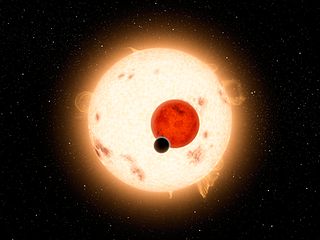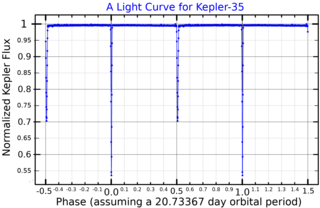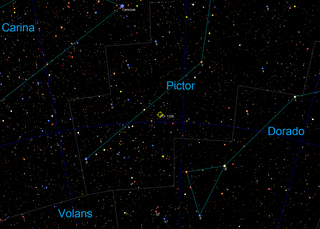Related Research Articles

These are lists of exoplanets. As of 7 December 2023, there are 5,557 confirmed exoplanets in 4,132 planetary systems, with 941 systems having more than one planet. Most of these were discovered by the Kepler space telescope. There are an additional 1,984 potential exoplanets from Kepler's first mission yet to be confirmed, as well as 977 from its "Second Light" mission and 4,571 from the Transiting Exoplanet Survey Satellite (TESS) mission.

Any planet is an extremely faint light source compared to its parent star. For example, a star like the Sun is about a billion times as bright as the reflected light from any of the planets orbiting it. In addition to the intrinsic difficulty of detecting such a faint light source, the light from the parent star causes a glare that washes it out. For those reasons, very few of the exoplanets reported as of April 2014 have been observed directly, with even fewer being resolved from their host star.

A circumbinary planet is a planet that orbits two stars instead of one. The two stars orbit each other in a binary system, while the planet typically orbits farther from the center of the system than either of the two stars. In contrast, circumstellar planets in a binary system have stable orbits around one of the two stars, closer in than the orbital distance of the other star. Studies in 2013 showed that there is a strong hint that a circumbinary planet and its stars originate from a single disk.

An exoplanet is a planet located outside the Solar System. The first evidence of an exoplanet was noted as early as 1917, but was not recognized as such until 2016; no planet discovery has yet come from that evidence. What turned out to be the first detection of an exoplanet was published among a list of possible candidates in 1988, though not confirmed until 2003. The first confirmed detection came in 1992, with the discovery of terrestrial-mass planets orbiting the pulsar PSR B1257+12. The first confirmation of an exoplanet orbiting a main-sequence star was made in 1995, when a giant planet was found in a four-day orbit around the nearby star 51 Pegasi. Some exoplanets have been imaged directly by telescopes, but the vast majority have been detected through indirect methods, such as the transit method and the radial-velocity method. As of 1 December 2023, there are 5,550 confirmed exoplanets in 4,089 planetary systems, with 887 systems having more than one planet. This is a list of the most notable discoveries.

Kepler-16b is an exoplanet. It is a Saturn-mass planet consisting of half gas and half rock and ice, and it orbits a binary star, Kepler-16, with a period of 229 days. "[It] is the first confirmed, unambiguous example of a circumbinary planet – a planet orbiting not one, but two stars," said Josh Carter of the Center for Astrophysics | Harvard & Smithsonian, one of the discovery team.

Kepler-16 is an eclipsing binary star system in the constellation of Cygnus that was targeted by the Kepler spacecraft. Both stars are smaller than the Sun; the primary, Kepler-16A, is a K-type main-sequence star and the secondary, Kepler-16B, is an M-type red dwarf. They are separated by 0.22 AU, and complete an orbit around a common center of mass every 41 days. The system is host to one known extrasolar planet in circumbinary orbit: the Saturn-sized Kepler-16b.

Kepler-34 is an eclipsing binary star system in the constellation of Cygnus. Both stars have roughly the same mass as the Sun and, like the Sun, both are spectral class G. They are separated by 0.22 AU, and complete an eccentric (e=0.5) orbit around a common center of mass every 27 days.

Kepler-35 is a binary star system in the constellation of Cygnus. These stars, called Kepler-35A and Kepler-35B have masses of 89% and 81% solar masses respectively, and both are assumed to be of spectral class G. They are separated by 0.176 AU, and complete an eccentric orbit around a common center of mass every 20.73 days.

Planet Hunters is a citizen science project to find exoplanets using human eyes. It does this by having users analyze data from the NASA Kepler space telescope and the NASA Transiting Exoplanet Survey Satellite. It was launched by a team led by Debra Fischer at Yale University, as part of the Zooniverse project.
Kepler-47 is a binary star system in the constellation Cygnus located about 3,420 light-years away from Earth. The stars have three exoplanets, all of which orbit both stars at the same time, making this a circumbinary system. The first two planets announced are designated Kepler-47b, and Kepler-47c, and the third, later discovery is Kepler-47d. Kepler-47 is the first circumbinary multi-planet system discovered by the Kepler mission. The outermost of the planets is a gas giant orbiting within the habitable zone of the stars. Because most stars are binary, the discovery that multi-planet systems can form in such a system has impacted previous theories of planetary formation.
PH1b, or by its NASA designation Kepler-64b, is an extrasolar planet found in a circumbinary orbit in the quadruple star system Kepler-64. The planet was discovered by two amateur astronomers from the Planet Hunters project of amateur astronomers using data from the Kepler space telescope with assistance of a Yale University team of international astronomers. The discovery was announced on 15 October 2012. It is the first known transiting planet in a quadruple star system, first known circumbinary planet in a quadruple star system, and the first planet in a quadruple star system found. It was the first confirmed planet discovered by PlanetHunters.org. An independent and nearly simultaneous detection was also reported from a revision of Kepler space telescope data using a transit detection algorithm.

Kepler-47c is an exoplanet orbiting the binary star system Kepler-47, the outermost of three such planets discovered by NASA's Kepler spacecraft. The system, also involving two other exoplanets, is located about 3,400 light-years away.

Kepler-296e is a confirmed super-Earth exoplanet orbiting within the habitable zone of Kepler-296. The planet was discovered by NASA's Kepler spacecraft using the transit method, in which the dimming effect that a planet causes as it crosses in front of its star is measured. NASA announced the discovery of the exoplanet on 26 February 2014.
Kepler-296 is a binary star system in the constellation Draco. The primary star appears to be a late K-type main-sequence star, while the secondary is a red dwarf.

Kepler-1647b is a circumbinary exoplanet that orbits the binary star system Kepler-1647, 3,700 light-years (1,100 pc) from Earth in the constellation Cygnus. It was announced on June 13, 2016, in San Diego at a meeting of the American Astronomical Society. It was detected using the transit method, when it caused the dimming of the primary star, and then again of the secondary star blended with the primary star eclipse. The first transit of the planet was identified in 2012, but at the time the single event was not enough to rule out contamination, or confirm it as a planet. It was discovered by the analysis of the Kepler light-curve, which showed the planet in transit.
Planet-hosting stars are stars which host planets, therefore forming planetary systems.

TOI-1338 is a binary star system located in the constellation Pictor, about 1,320 light-years from Earth. It is orbited by two known circumbinary planets, TOI-1338 b, discovered by the Transiting Exoplanet Survey Satellite (TESS) and BEBOP-1c, discovered by the Binaries Escorted By Orbiting Planets project.
References
- 1 2 3 4 5 6 "Kepler-453 b Confirmed Planet Overview Page". NASA Exoplanet Archive. Retrieved 2015-10-08.
- ↑ Welsh, William F.; et al. (2015). "Kepler 453 b - The 10th Kepler Transiting Circumbinary Planet". The Astrophysical Journal. 809 (1). 26. arXiv: 1409.1605 . Bibcode:2015ApJ...809...26W. doi:10.1088/0004-637X/809/1/26. S2CID 55158342.
- ↑ Martin, David V. (2017). "Circumbinary planets - II. When transits come and go". Monthly Notices of the Royal Astronomical Society. 465 (3): 3235–3253. arXiv: 1611.00526 . Bibcode:2017MNRAS.465.3235M. doi:10.1093/mnras/stw2851. S2CID 119187045.


